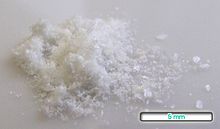Aminophenazone
| Structural formula | |||||||||||||||||||
|---|---|---|---|---|---|---|---|---|---|---|---|---|---|---|---|---|---|---|---|

|
|||||||||||||||||||
| General | |||||||||||||||||||
| Non-proprietary name | Aminophenazone | ||||||||||||||||||
| other names |
|
||||||||||||||||||
| Molecular formula | C 13 H 17 N 3 O | ||||||||||||||||||
| Brief description |
light-sensitive, flammable, white to almost white crystalline powder or colorless crystals |
||||||||||||||||||
| External identifiers / databases | |||||||||||||||||||
|
|||||||||||||||||||
| Drug information | |||||||||||||||||||
| ATC code | |||||||||||||||||||
| properties | |||||||||||||||||||
| Molar mass | 231.30 g mol −1 | ||||||||||||||||||
| Physical state |
firmly |
||||||||||||||||||
| Melting point |
107-108.5 ° C |
||||||||||||||||||
| solubility |
|
||||||||||||||||||
| safety instructions | |||||||||||||||||||
|
|||||||||||||||||||
| As far as possible and customary, SI units are used. Unless otherwise noted, the data given apply to standard conditions . | |||||||||||||||||||
Aminophenazone is a chemical compound from the group of nitrogen heterocycles or pyrazolone derivatives. It consists of the pyrazolone skeleton (known in fever and pain therapy) with an amino group in the 4-position of the pyrazolone heterocycle.
history
Friedrich Stolz and Ludwig Knorr are considered to be the inventors of aminophenazone, which Hoechst launched in 1897 as Pyramidon ® .
Extraction and presentation
Aminophenazone can be obtained from phenazone by nitration and subsequent reduction.
use
Aminophenazon is a pyrazolone (pyrazolin-3-one) with analgesic, anti-inflammatory and antipyretic properties (i.e. it is a non-opioid analgesic with three times more activity than phenazone), but has the risk of agranulocytosis . A breath test with 13 C-labeled aminopyrine was used for the non-invasive measurement of cytochrome P-450 activity in the liver. Aminophenazone as a further development of phenazone may only be used veterinary (in the early stages of septic shock in dogs and cats and in combination with phenylbutazone ) due to the carcinogenic metabolite dimethylnitrosamine and has been replaced by propyphenazone in combination preparations since 1977 .
Pharmacokinetics
After oral administration, aminophenazone is rapidly absorbed . There is low protein binding . In rats, an increased concentration in the nasal mucosa and in the liver could be detected 30 minutes after administration. 4-Acetylamino-3-methyl-1-phenylpyrazolone was detected in the urine. This suggests oxidative N -dealkylation by the MFO system (cytochrome P450-containing monooxygenases or mixed-function oxygenases) in the liver and subsequent acetylation of the free, primary amino group. An analogous mechanism is observed in the metabolism of the structurally very similar metamizole metabolite 4-methylaminophenazone after its absorption. The rate of metabolism by the cytochrome P450 system in rats depends on the time of day. Renal aminophenazon is either unchanged glucoronidiert or sulfated excreted. There are also reports of rubazonic acid excretion , which can cause the urine to turn red.
See also
Individual evidence
- ↑ a b c d e Entry on aminophenazone in the GESTIS substance database of the IFA , accessed on February 14, 2017(JavaScript required) .
- ↑ a b European Pharmacopoeia 6.2
- ↑ Pharmaceutical Chemistry - Part 6 - Non-Opioid Analgesics (PDF; 529 kB).
- ^ A. Rocco, G. de Nucci, G. Valente, D. Compare, A. D'Arienzo, L. Cimino, F. Perri, G. Nardone: 13C-aminopyrine breath test accurately predicts long-term outcome of chronic hepatitis C. In: Journal of hepatology. Volume 56, Number 4, April 2012, pp. 782-787, doi: 10.1016 / j.jhep.2011.10.015 . PMID 22173159 .
- ↑ Entry on aminophenazone at Vetpharm, accessed on June 23, 2012.
- ↑ J. Gasteiger, A. Schunk, University of Erlangen: Heterocyclen als Arzneimittel .
- ^ A b D. E. Hathway: Foreign compound metabolism in mammals, volume 2. The Chemical Society, Burlington House, London, WIV OBN, England, 1972. xv + 513 pp. 14.5 In: Journal of Pharmaceutical Sciences . 62, 1973, p. 186, doi: 10.1002 / jps.2600620954 .
- ↑ a b Jones, LM, et al. Veterinary Pharmacology & Therapeutics. 4th ed. Ames: Iowa State University Press, 1977., p. 363 .
- ↑ Goodman, LS, and A. Gilman. (eds.) The Pharmacological Basis of Therapeutics. 5th ed. New York: Macmillan Publishing Co., Inc., 1975., p. 347 .
- ↑ Brittebo EB; Acta Pharmacol Toxicol , 51 (3): 227 (1982) .
- ^ Sullivan, JB Jr., GR Krieger (eds.). Hazardous Materials Toxicology-Clinical Principles of Environmental Health. Baltimore, MD: Williams and Wilkins, 1992., p. 119 .
- ↑ a b Mutschler drug effects, 9th edition, Wissenschaftl. Verlagsgesellschaft mbH Stuttgart, pp. 251 f., ISBN 978-3-8047-1952-1 .
- ↑ Doull, J., CD Klaassen, and MD Amdur (eds.). Casarett and Doull's Toxicology. 2nd ed. New York: Macmillan Publishing Co., 1980., p. 67 .
- ↑ H. Oelschl: Drug Metabolism: Chemical and Biochemical Aspects of B. Testa and P. Jenner, 700 S., Marcel Dekker, Inc., New York, 1976. In: Archives of pharmacy. 311, 1978, p. 165, doi: 10.1002 / ardp.19783110215 .

